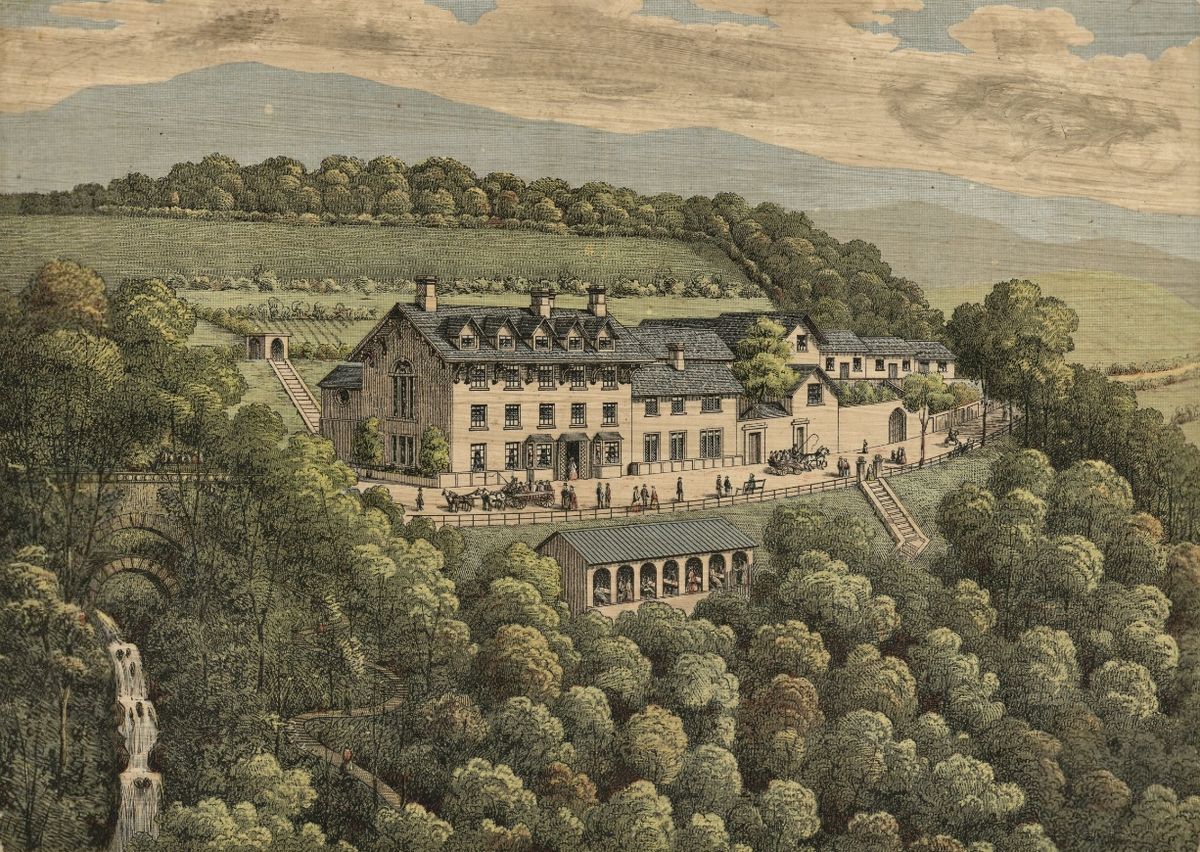Thursday 8th July 1819
Thursday July 8th We had intended passing this day in surveying three very beautiful Waterfalls seven miles from Dolgilly the ride to them is very beautiful the first called Rhaiader Dolmelynllyn (an easy Welsh name) is 60 feet long and continues rising through
a bed of rocks for half a mile, the second called Rhaeadr Mawddach falls down a rock of 60 feet; and Pistill Cain considered the finest rushes down a rock of 150 feet high in my opinion they all surpass the Devils Bridge and are most romantically situated we arrived at the Inn very late.
OBSERVATIONS & COMMENTS:
Waterfalls became places of tourism and recreation in eighteenth-century Wales and by the heyday of the Celtic Tour at the end of the eighteenth century and the beginning of the nineteenth they had achieved a special status as one of the iconic features of the Welsh landscape. There was a developing interest in natural scenery in Wales earlier in the eighteenth century, and waterfall scenery was incorporated into private parks. Waterfalls were sought out by travellers through North and South Wales, the consequence of which was that the waterfall became one of the chief aesthetic thrills of the period. Interest waned in the nineteenth century when waterfalls could no longer be relished as undiscovered and tourists were drawn further afield. Aesthetic attitudes also changed. The waterfall was no longer part of a social scene, nor was it viewed as a part of a harmonious landscape that contrasted rural with urban life. The waterfall became a work of nature in its own right. https://www.tandfonline.com/doi/full/10.1179/1466203513Z.00000000017?scroll=top&needAccess=true
Rhaiader Dolmelynllyn: We were unable to identify any falls called Rhaeadr Dolmelynllyn but Lucy would have been referring to Rhaeadr Du, an impressive set of falls that have a total drop of over sixty feet and take their name from the slab of black rock over which the water of Afon Gamlan cascades. Lucy writes that Rhaeadr Dolmelynllyn is 60 feet long , the length quoted in Snowdonia Guide for Rhaeadr Du. Our reader, Roger Hird, has kindly confirmed this and writes: "Rhaeadr Dolmelynllyn" is clearly the waterfall now called Rhaedr Ddu, in Ganllwyd. Dolmelynllyn is the name of the old house which was rebuilt in the 19th century and is now a hotel - about a quarter of a mile to the south of the falls. The falls are on the estate originally associated with the house.
The house, by the way, is in some way linked to William Maddocks the London lawyer (with Welsh connections) who built the village of Tremadoc and the the town of Portmadoc (now Tremadog and Porthmadog) - and who drained the estuary of Afon Glaslyn, the Traeth Mawr. He had bought a house above the traeth, Tan-yr-Allt but I remember suggestions that he had stayed at or perhaps borrowed the Dolmelynllyn house. I haven't tracked down the source of this.
From Snowdonia Guide http://www.snowdoniaguide.com/rhaeadr_du.htm
From the Nationakl Trust: https://www.nationaltrust.org.uk/trails/-rhaeadr-ddu-and-coed-ganllwyd-walk
The Afon Gamlan is a short river which flows through the Cwm Camlan Valley into the Mawddach at Ganllwyd north of Dolgellau. http://www.snowdoniaguide.com/rhaeadr_du.htm and https://www.nationaltrust.org.uk/trails/-rhaeadr-ddu-and-coed-ganllwyd-walk
Rhaeadr Mawddach: Rhaeadr Mawddach is a small waterfall in the river Afon Mawddach located in the Coed y Brenin forest (Snowdonia), which means forest of the kings. It is a mighty waterfall (after rainfall) that drops down over 35 meters in three jumps. Although the waterfall isn’t as high as Pistyll Cain , the volume is much bigger. Pistyll Cain is located near the Rhaeadr Mawddach in the river that runs to the west, Afon Gain. Pistyll is Welsh word for waterfall. http://www.europeanwaterfalls.com/waterfalls/rhaeadr-mawddach/
Image by PhotoEverywhere.co.uk from http://www.europeanwaterfalls.com/waterfalls/rhaeadr-mawddach/
Just below the fall are the remains of the Gwynfynydd Goldmine. The English Royal family traditionally have wedding rings made from Welsh gold.
Pistyll Cain is a waterfall with height of 20 meter in the river Afon Gain located in the Coed y Brenin forest (Snowdonia), which means forest of the kings. Here the river Afon Gain tumbles down over a rock cliff in a gorgeous surrounding. http://www.europeanwaterfalls.com/waterfalls/pistyll-cain/
1813 - Fall of the Cayne, north Wales,engraved by M S Barenger from the collection of the National Library of Wales Accession number 1130569 made available under the Creative Commons CC0 1.0 Universal Public Domain Dedication. https://commons.wikimedia.org/wiki/File:Fall_of_the_Cayne,_north_Wales_(1130569).jpg
2009: Pistyll Cain Waterfall, author Keith Ruffles, Source https://www.panoramio.com/photo/27339483 licensed under the Creative Commons Attribution 3.0 Unported license. From https://commons.wikimedia.org/wiki/File:Pistyll_Cain_Waterfall_-_panoramio_(1).jpg
A YouTube video of Pistyll Cain by Stewart Jones, Published on 6 Jun 2017, can be sourced here
PISTYLL CAIN WATERFALL @ COED Y BRENIN
The print, above was published in 1813, not long before Lucy’s visit. It differs little from the photograph of 2009
Can you help us?
Old Regency Prints, Pictures an Coaching maps: Do you have access to any prints or pictures showing what town and country would have looked like when Lucy travelled through? Any illustrations of what she would have seen in 1819 will enliven our research.
New Pictures: Do you have any modern pictures of the streets, buildings, gardens and views that would enable us to see the changes that two centuries have wrought?
Corrections and advice are welcomed


























































































































































































